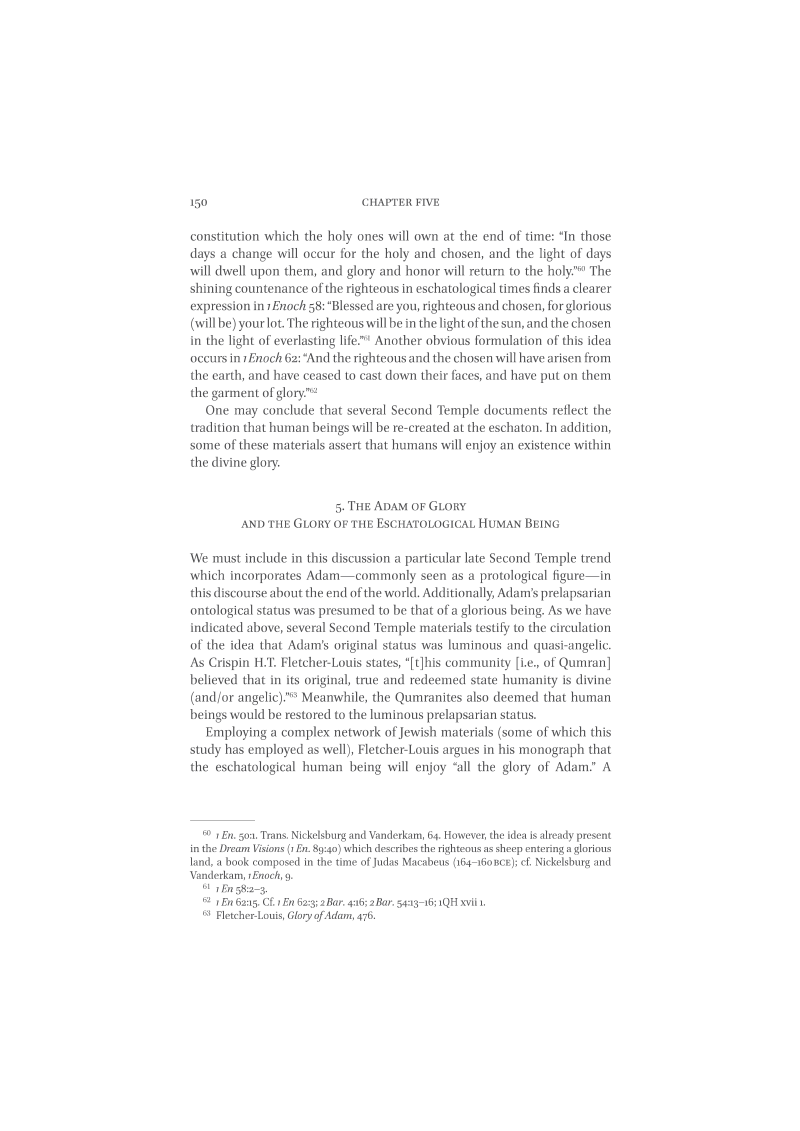Dragoş Andrei Giulea comments on Second Temple Jewish texts promising the faithful they will inherit the pre-fallen "glory of Adam."
- Type
- Book
- Source
- Dragoş Andrei Giulea Non-LDS
- Hearsay
- Secondary
- Reference
Dragoş Andrei Giulea, Pre-Nicene Christology in Paschal Contexts: The Case of the Divine Noetic Anthropos (Supplements to Vigiliae Christianae Texts and Studies of Early Christian Life and Language 123; Leiden: Brill, 2014), 150-53
- Scribe/Publisher
- Brill
- People
- Dragoş Andrei Giulea
- Audience
- Reading Public
- Transcription
THE ADAM OF GLORY
AND THE GLORY OF THE ESCHATOLOGICAL HUMAN BEING
We must include in this discussion a particular late Second Temple trend which incorporates Adam—commonly seen as a protological figure—in this discourse about the end of the world. Additionally, Adam’s prelapsarian ontological status was presumed to be that of a glorious being. As we have indicated above, several Second Temple materials testify to the circulation of the idea that Adam’s original status was luminous and quasi-angelic. As Crispin H.T. Fletcher-Louis states, “[t]his community [i.e., of Qumran] believed that in its original, true and redeemed state humanity is divine (and/or angelic).” Meanwhile, the Qumranites also deemed that human beings would be restored to the luminous prelapsarian status.
Employing a complex network of Jewish materials (some of which this study has employed as well). Fletcher-Louis argues in his monograph that the eschatological human being will enjoy “all the glory of Adam.” A remarkable passage of the Community Rule synthesizes, in a wonderful manner, the eschatological re-creation of the human being, its purification from any unclean spirit, and its refashioning to the primordial glory of Adam.
God in the mysteries of his knowledge and in the wisdom of his glory, has determined an end to the existence of injustice and on the appointed time of the visitation he will obliterate it for ever. Then truth shall rise up forever (in) the world, for it has been defiled in paths of wickedness during the dominion of injustice until the time appointed for judgment decided. Then God will refine, with his truth, all man’s deeds, and will purify for himself the structure of man (מבני איש), ripping out all spirit of injustice from the innermost part of his flesh, and cleansing him with the spirit of holiness (ברוח קודש) from every wicked deeds. He will sprinkle over him the spirit of truth like lustral water (in order to cleanse him) from all the abhorrences of deceit and (from) the defilement of the unclean spirit, in order to instruct the upright ones with knowledge of the Most High, and to make understand the wisdom of the sons of heaven to those of perfect behavior. For those God has chosen for an everlasting covenant and to them shall belong all the glory of Adam (כול כבוד אדם).
Within the same era, the Damascus Document makes the following affirmation about the restored people of Israel:
But God, in his wonderful mysteries, atoned for the iniquity and pardoned their sin. And he built them a safe house in Israel, such as there has not been since ancient times, not even till now. Those who remained steadfast in it will acquire eternal life, and all the glory of Adam (כול כבוד אדם) is for them.
Additionally, two other key materials for our discussion are the Life of Adam and Eve and one of its versions, the Apocalypse of Moses. In addition to the fact that these two documents conceive of the primordial Adam as a luminous being, Vita 13-16 recounts the fall of Satan who declined the divine commandment to worship Adam, the image of God: “And Michael went out and called all the angels, saying, ‘Worship the image of the Lord God, as the Lord God has instructed.’” The text correlates, therefore, the ideas of divine glory, the image of God, and the primordial Adam. However, the passage describes this Adam as created, and not as the eternal image of God.
Adam’s saga in the Apocalypse continues with his repentance and the way God restored the angels coming on earth, taking Adam’s dead body to Paradise (Apoc. Mos. 39:1) and washing his soul three times in the presence of God. The Lord God commands the angels to then cover Adam’s body with cloths of linen brought from Paradise:
[O]ne of the six-winged seraphim came and carried Adam off to the Lake of Acheron and washed him three times in the presence of God. He lay three hours, and so the Lord of all, sitting on his holy throne, stretched out his hands and took Adam and handed him over to the archangel Michael, saying to him, “Take him up into Paradise, to the third heaven, and leave (him) there until that great and fearful day which I am about to establish for the world.”
Then he [God] spoke to the archangel Michael, “Go into Paradise in the third heaven and bring me three cloths of linen and silk (τρεις σινδονας βυσσινας και σηρικας).” And God said to Michael, Gabriel, Uriel, and Raphael, “Cover Adam’s body with the cloths and bring oil of fragrance and pour it on him (ελαιον εκ του ελαιου της ευωδιας εκχεατε επ’ αυτον).”
The gesture of covering Adam with white clothes and oil echoes the Enochic passage where God commands his angels to cover with garments of glory and anoint the inspired scribe Enoch. The Vita relates in the same fashion how angels take Adam’s soul and clothe him with three linen garments:
“Again the Lord said to the angels Michael and Uriel: ‘Bring me three linen shrouds (sindones bissinas) and stretch them over (expandite super) Adam.’”
- Citations in Mormonr Qnas
The B. H. Roberts Foundation is not owned by, operated by, or affiliated with the Church of Jesus Christ of Latter-day Saints.

